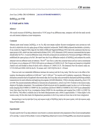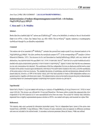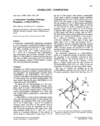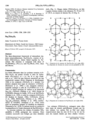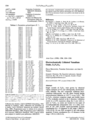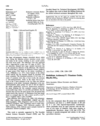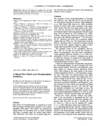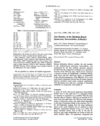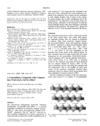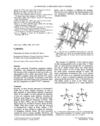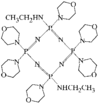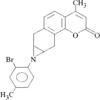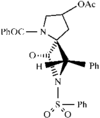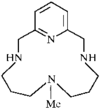issue contents
September 1998 issue

Cover illustration: Tetraethylammonium (1-Pyrrolidinecarbodithioato-S,S')(tetrathiotungstenio-S,S')nickelate(1-), see Long, Wang & Huang, pages 1251-1253. Displacement ellipsoids are shown at the 30% probability level and H atoms have been omitted for clarity.
cif-access (inorganic compounds)
Download citation


Download citation


The structure of strontium nitrate, originally determined with neutron radiation at room temperature [Nowotny & Heger (1983). Acta Cryst. C39, 952-956], has been redetermined using X-ray analysis at 173 K.
Download citation


Download citation


Better data have enabled eight Na+ cations per [Ce(W5O18)2]8− anion to be identified, in contrast to the six found earlier [Iball et al. (1974). J. Chem. Soc. Dalton Trans. pp. 2021-2024]. The two W5O186− ligands, related by a crystallographic twofold axis through the square antiprismatic CeO8 group, are therefore unprotonated.
cif-access (metal-organic compounds)
Download citation


Download citation


The structure is isomorphous with that of the bis(thioselenato) analog, with the Ni atom lying on a center of symmetry.
Download citation


Download citation


The title compound consists of discrete neutral complexes with crystallographic C2 symmetry. The Fe-O bond distances are 2.0556 (12) and 2.0937 (13) Å, and the Fe-N bond distance is 2.2290 (16) Å.
inorganic compounds
Download citation


Download citation


α-(NH4)V(HPO4)2 is a new ammonium vanadium(III) phosphate, built up from a three-dimensional framework of VO6 octahedra and HPO4 tetrahedra.
Download citation


Download citation


Triammonium dizinc vanadium bis(phosphate) bis(hydrogen phosphate) is built up from a three-dimensional network of VO6 octahedra and ZnO4, PO4 and HPO4 tetrahedra. NH4+ cations occupy two different interstices in the framework.
Download citation


Download citation


Tetrasodium titanium nonaoxodiarsenate, Na4TiAs2O9, is built up from infinite [TiO(AsO4)2]n chains linked together by Na+ cations.
Download citation


Download citation


The three-dimensional network structure of this compound comprises VO5 pyramids and (As,V)2O7 groups sharing corners to form puckered layers. The layers are linked to each other by chains of VO6 octahedra. Cs2V3(As0,635V0,365)4O17 is isostructural with Cs2V3P4O17.
Download citation


Download citation


Li3V6O13 is found to be the composition of the phase formed (at 2.45 V versus Li/Li+) on electrochemical lithiation of V6O13; this phase retains the C2/m space group of V6O13.
Download citation


Download citation


In the novel title rubidium antimonate, Sb has both octahedral and trigonal-bipyramidal coordination. These polyhedra build up a network with channels containing Rb, forming a structure similar to that of pyrochlore.
Download citation


Download citation


ZnNiP4O12 is composed of cyclic [P4O12] groups forming sheets parallel to the crystallographic (100) plane. These sheets are separated by zigzag chains of alternating NiO6 or ZnO6 octahedra that share a common edge, the cations being statistically disordered.
Download citation


Download citation


ErRh2B2C is the end member of the rhodium-based quaternary borocarbides. The structure of ErRh2B2C can be viewed as a layered structure of tetrahedrally coordinated Rh2B2 layers and ErC NaCl-type layers.
Download citation


Download citation


The tetracalcium dialuminium hydroxide carbonate pentahydrate Ca4Al2(OH)12CO3.5H2O is a layered compound encountered in the chemistry of cement paste. It is composed of positively charged [Ca4Al2(OH)12]2+ main layers and negatively charged [CO3.5H2O]2− interlayers. The Al3+ and Ca2+ ions are six- and sevenfold coordinated, respectively, by O atoms. The planar CO32− groups are directly connected to the main layers and tilted by 21.8 (9)° from the planes formed by these layers.
Download citation


Download citation


V2MnTeO7 is an MnII/VIV tellurite compound which contains slabs of TeO3+1 units, MnO6 octahedra, VO5 square pyramids, and distorted VO6 octahedra.
Download citation


Download citation


CsSbO2 crystallizes in the monoclinic space group C2/c, is isotypic with NaBiO2 and CsBiO2, and contains infinite ∞1[SbO2/2O'2/2] chains running parallel to [001].
metal-organic compounds
Download citation


Download citation


Download citation


Download citation


Download citation


Download citation


Download citation


Download citation


Download citation


Download citation


Download citation


Download citation


Download citation


Download citation


Download citation


Download citation


Download citation


Download citation


Download citation


Download citation


Download citation


Download citation


Download citation


Download citation


Download citation


Download citation


Download citation


Download citation


Download citation


Download citation


Download citation


Download citation


Download citation


Download citation


Download citation


Download citation


Download citation


Download citation


Download citation


Download citation


Download citation


Download citation


Download citation


Download citation


Download citation


Download citation


Download citation


Download citation


Download citation


Download citation


Download citation


Download citation


organic compounds
Download citation


Download citation


Download citation


Download citation


Download citation


Download citation


Download citation


Download citation


Download citation


Download citation


Download citation


Download citation


Download citation


Download citation


Download citation


Download citation


Download citation


Download citation


Download citation


Download citation


Download citation


Download citation


Download citation


Download citation


Download citation


Download citation


Download citation


Download citation


Download citation


Download citation


Download citation


Download citation


Download citation


Download citation


Download citation


Download citation


Download citation


Download citation


Download citation


Download citation


Download citation


Download citation


Download citation


Download citation


Download citation


Download citation


Download citation


Download citation


Download citation


Download citation


The title compound is cubic (space group Pa3) and not orthorhombic (space group Pbca) as reported [Azumaya, Kagechika, Yamaguchi & Shudo (1995). Tetrahedron, 51, 5277–5290].
Download citation


Download citation


Download citation


Download citation


Download citation


Download citation


Download citation


Download citation


Download citation


Download citation


Download citation


Download citation


Download citation


Download citation


Download citation


Download citation


Download citation


Download citation


Download citation


Download citation


Download citation


Download citation


Download citation


Download citation


Download citation


Download citation


Download citation


Download citation




 journal menu
journal menu











